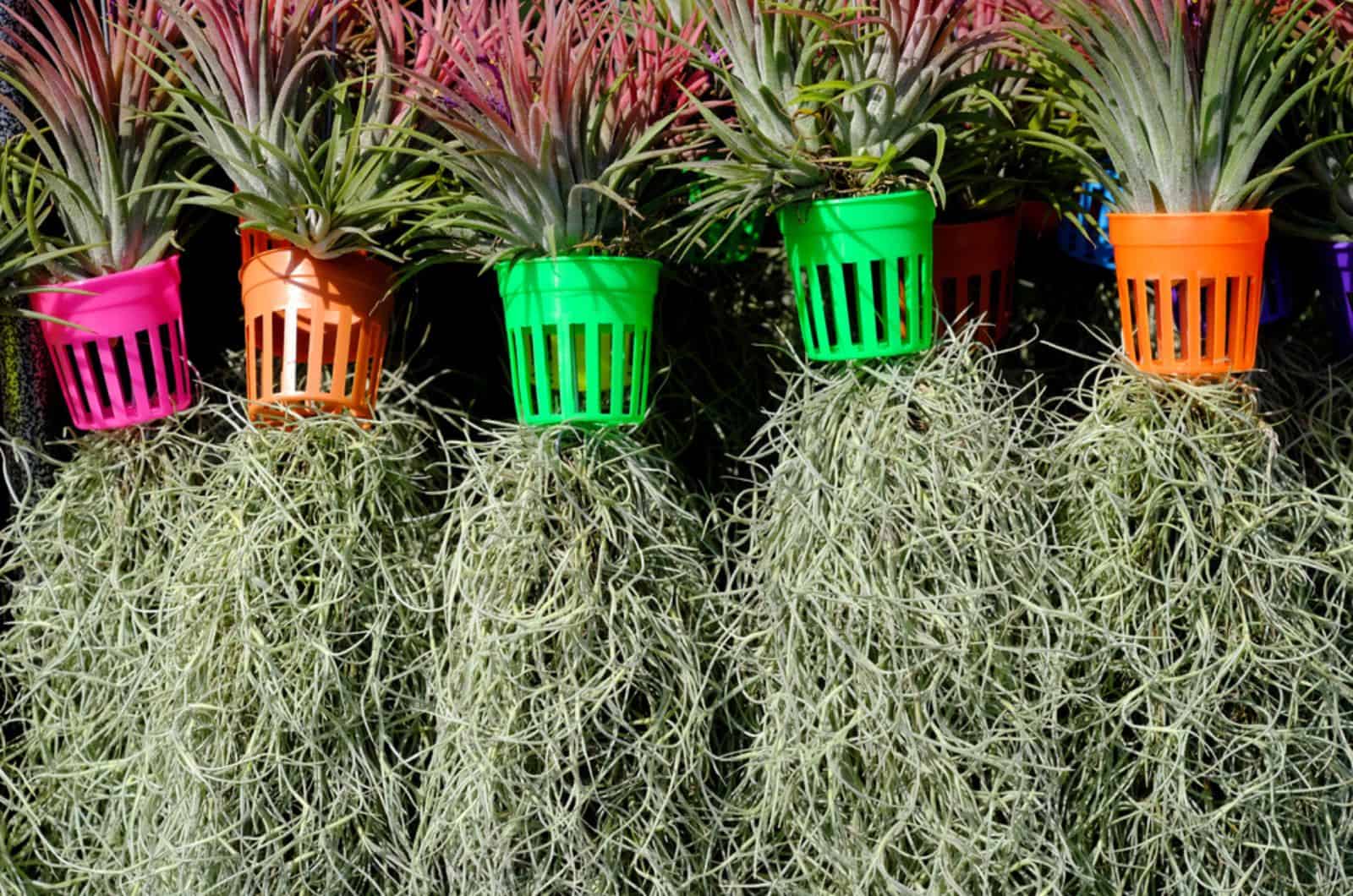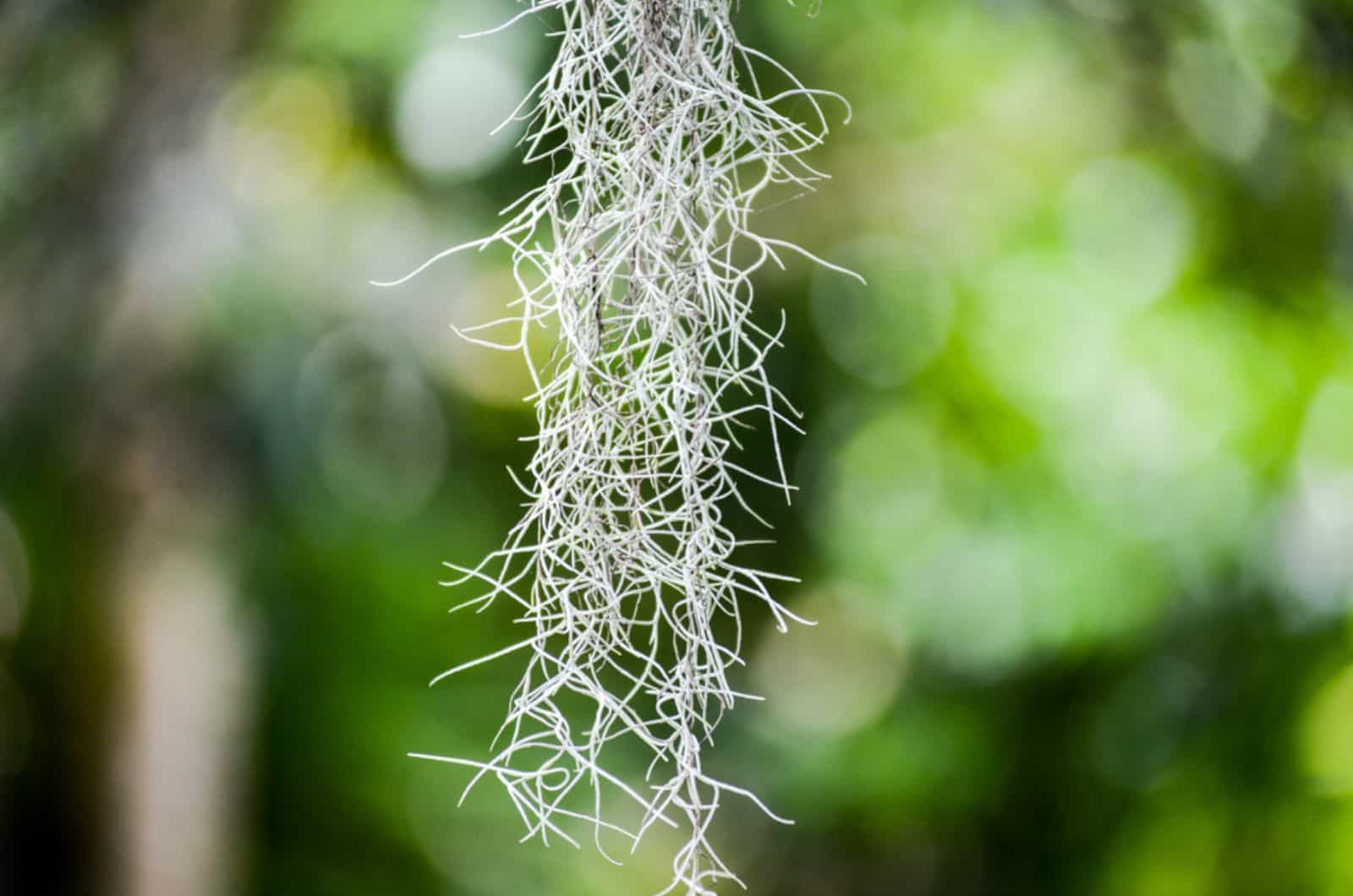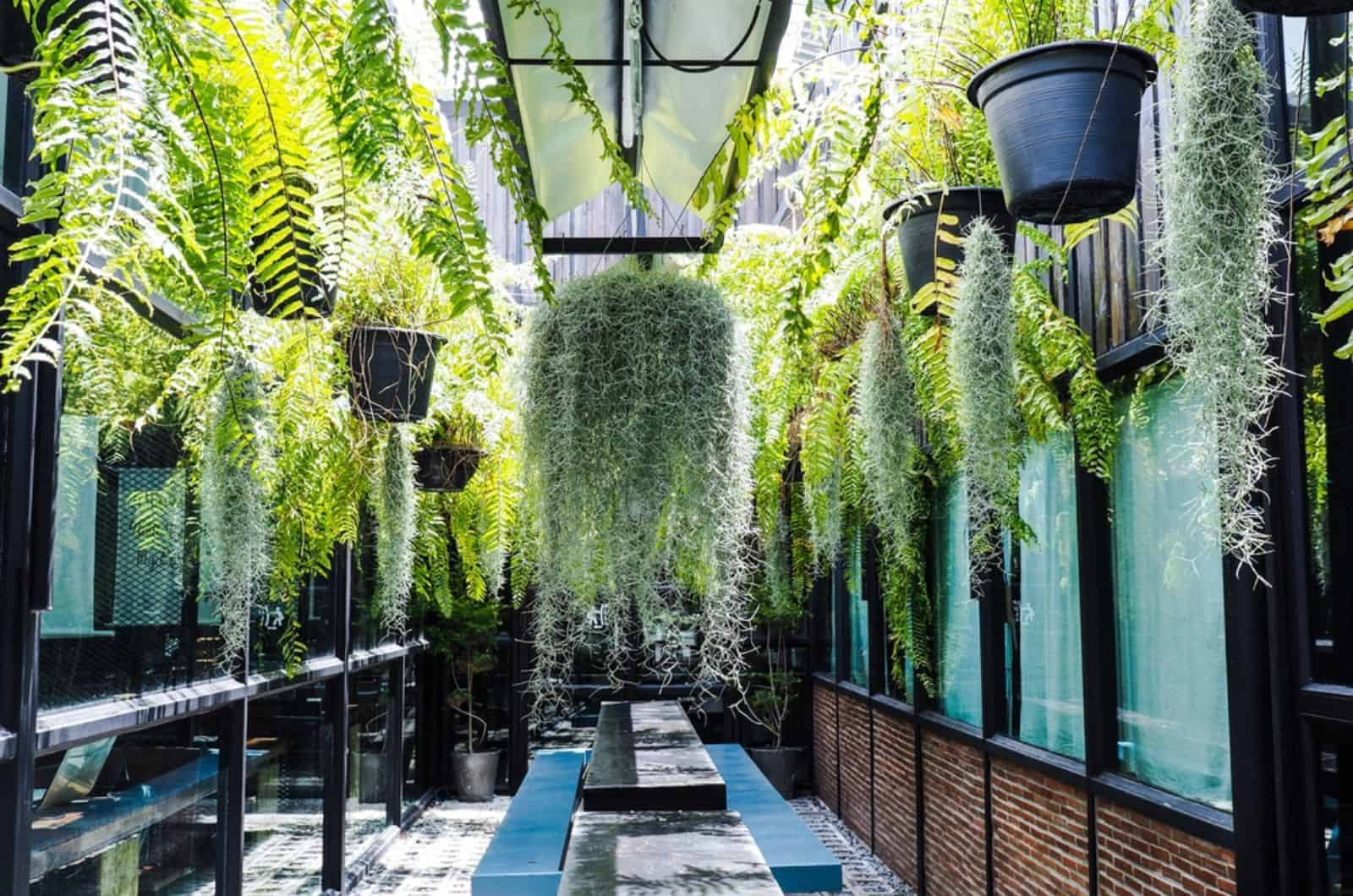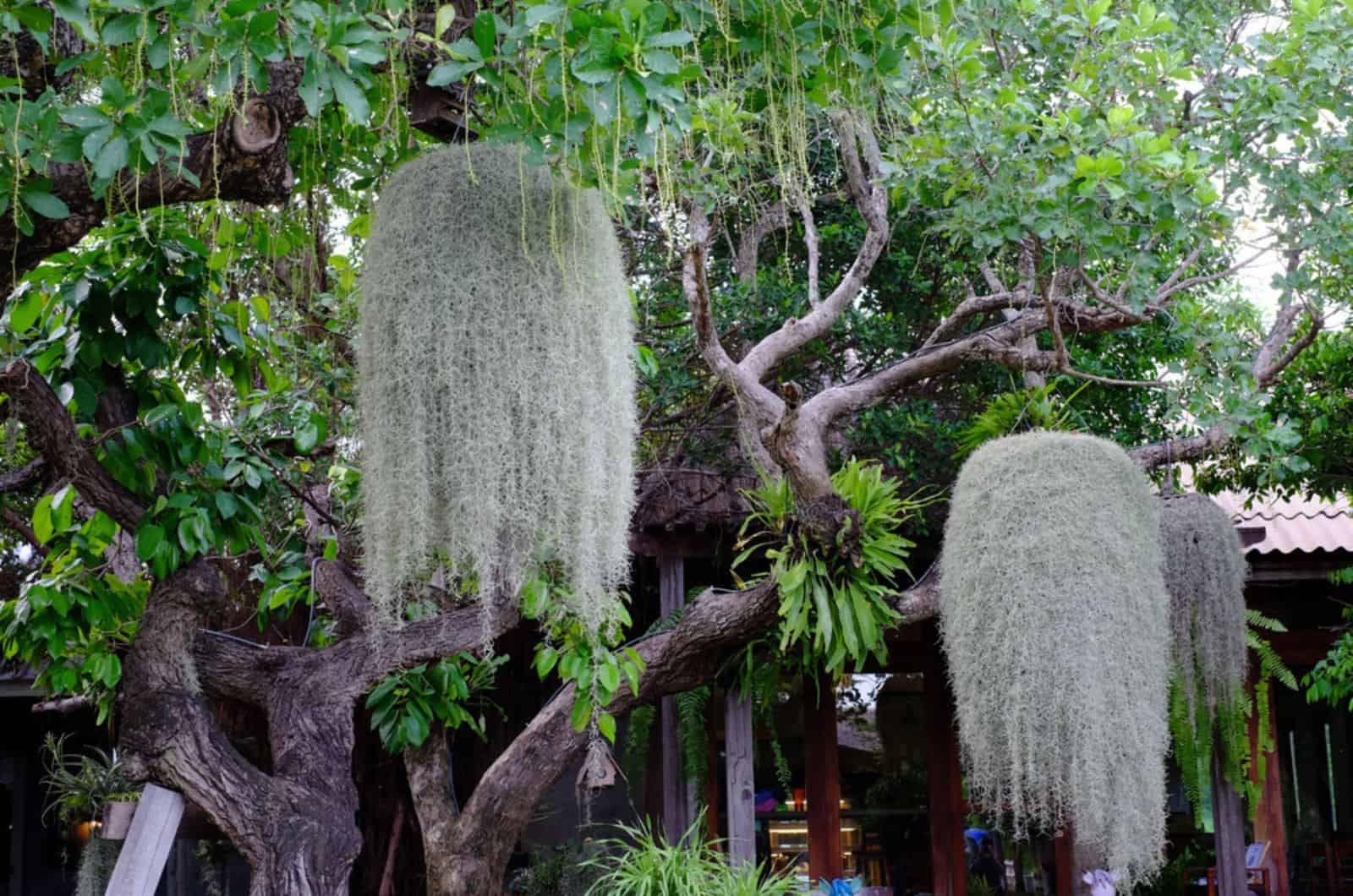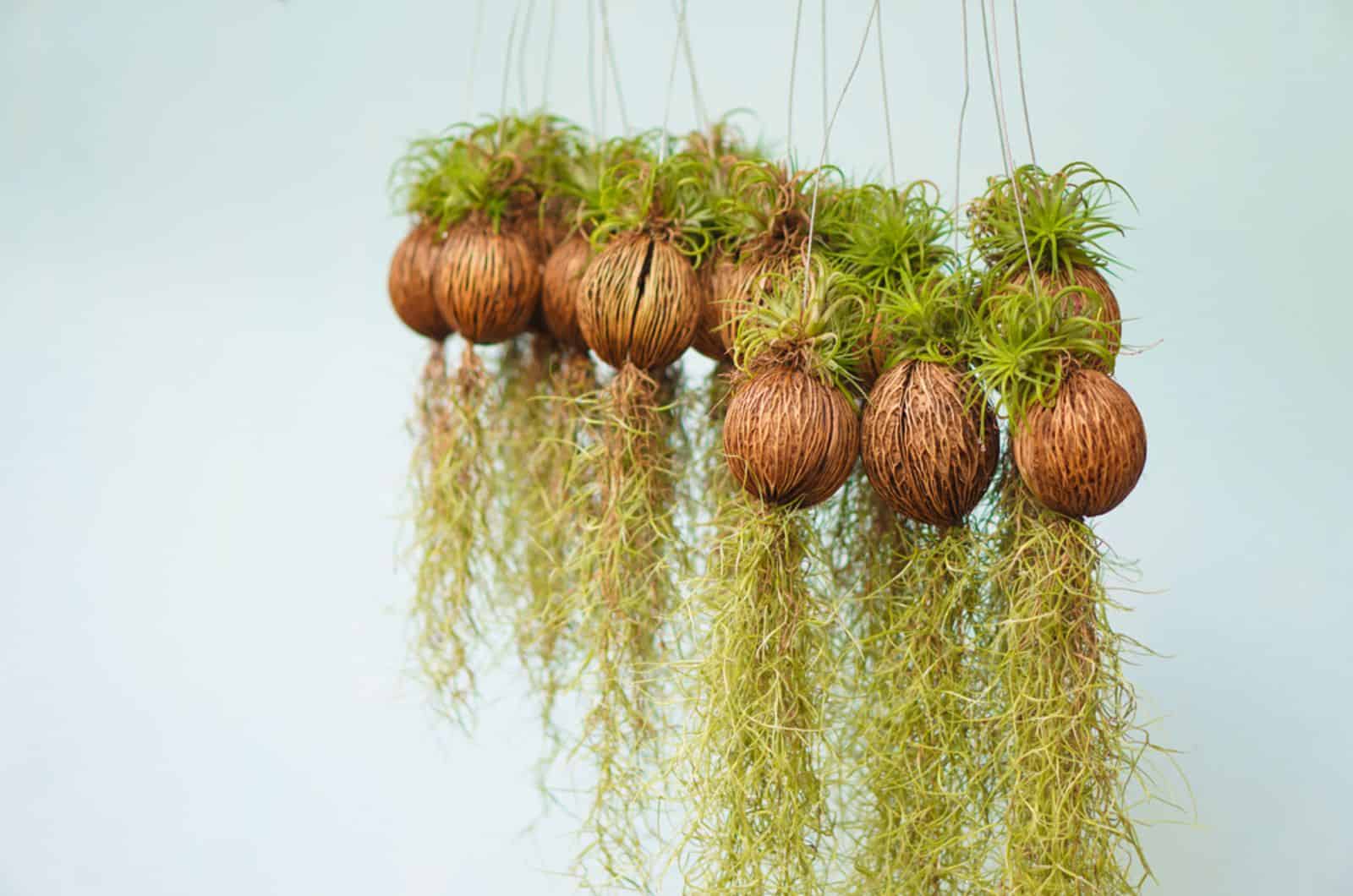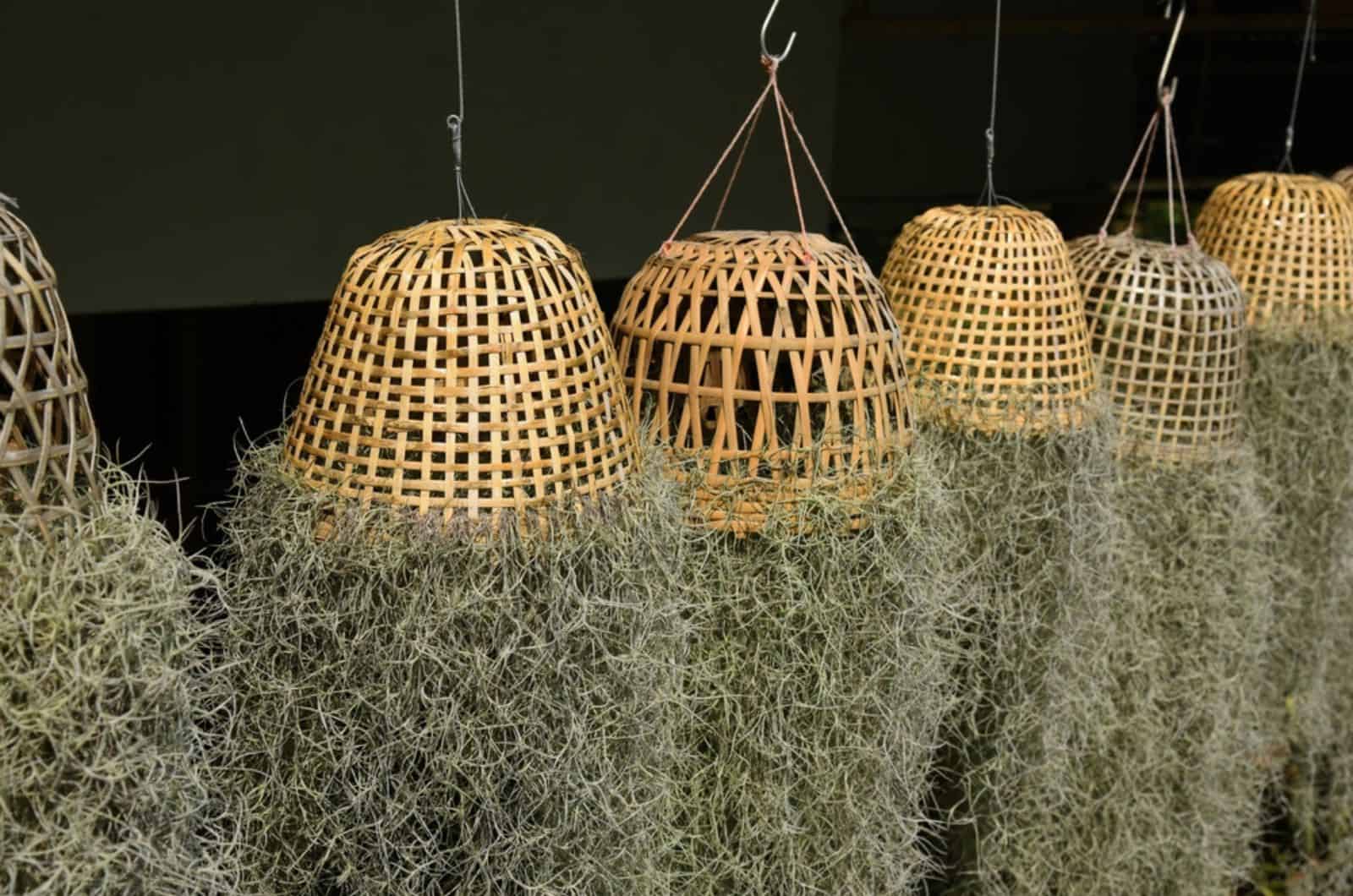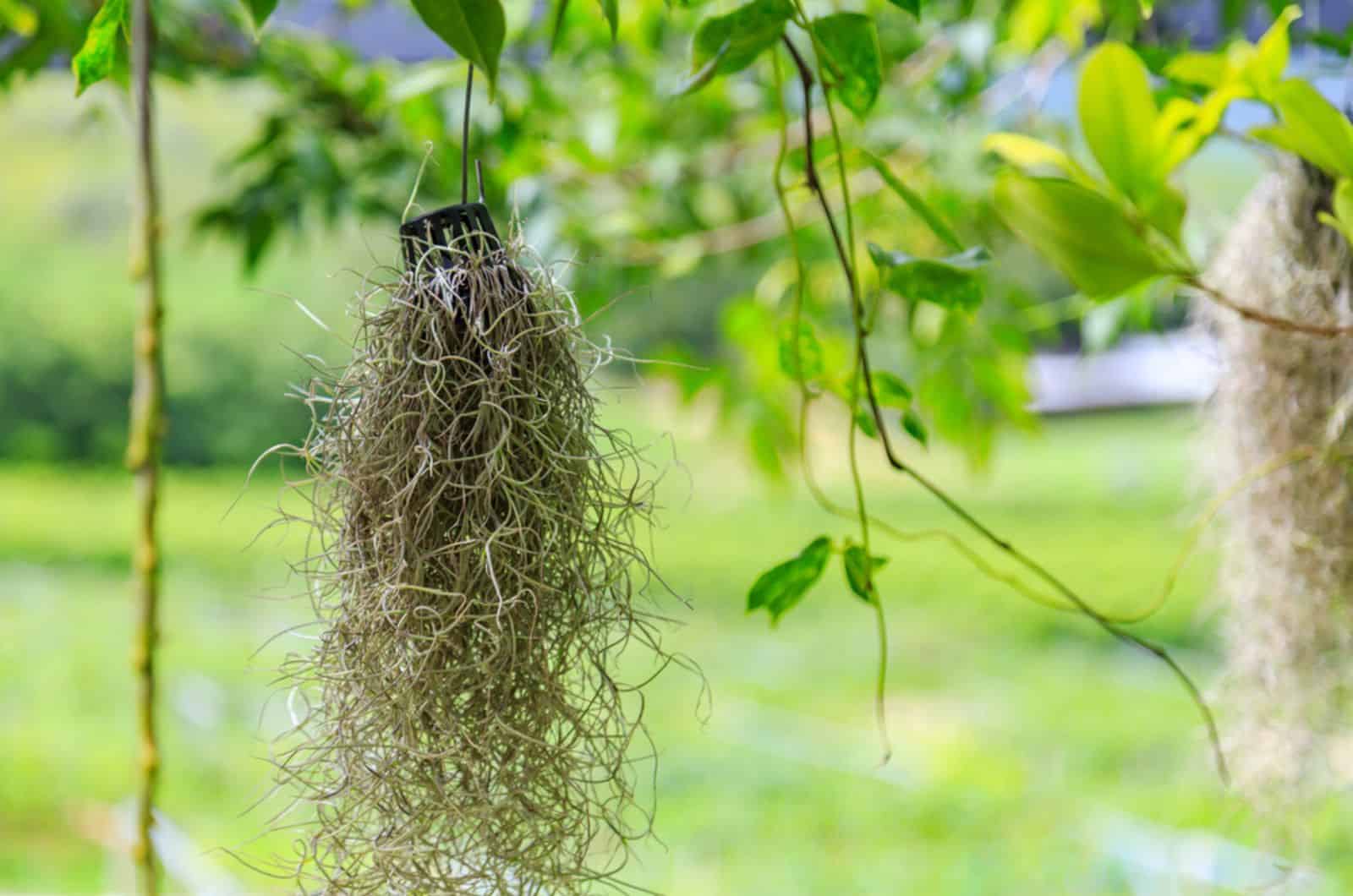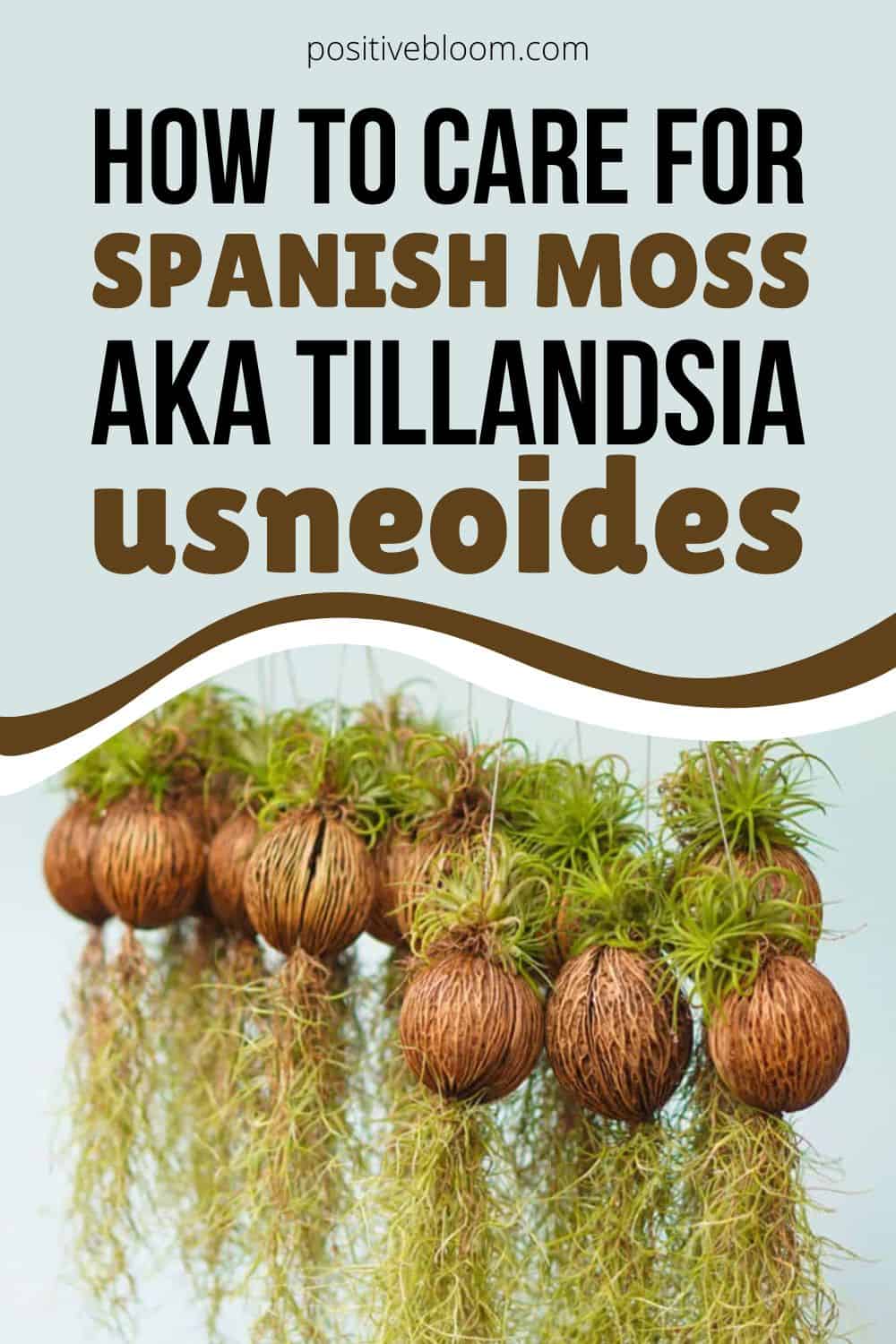There was a time I couldn’t imagine being remotely interested in moss. Now, I love this type of plant and have done a lot of research to master the skill of growing it.
When I first heard of Spanish moss, I really thought it was moss and required the same conditions. However, this plant isn’t a moss at all, but rather a bromeliad, the cousin of pineapple.
I decided to show you how to care for Spanish moss and resolve the confusion with the nicknames so you don’t make the same mistake. Otherwise known as Tillandsia Usneoides, Spanish moss can be grown outdoors but looks impressive and grows well as a houseplant.
Let’s first find out some basic info about this plant:
[table id=315 /]Let’s get started!
How To Care For Spanish Moss Indoors
Many think of Spanish moss as an outdoor plant, but it makes for a perfect indoor plant when provided with the right conditions.
So, what does Spanish moss need to thrive? You’ll need to ensure bright indirect light, warm temperatures, high humidity, and also feed it from time to time.
There’s much more to learn, so keep reading to find out everything!
Light Requirements
When discussing the perfect light level for this air plant, we must consider its natural habitat. Bromeliad plants are classified as epiphytes, which means they are attached to other trees.
What does this actually mean in terms of light? The dense foliage of large trees in subtropical areas filters the sunlight, which means Spanish moss isn’t exposed to direct sunlight in its native habitat.
You need to find a location for your tree hair where it can get bright light, similar to its native area, but it needs to be indirect because direct light can damage the plant.
When grown as a houseplant, Spanish moss is most commonly placed on windowsills, and if you decide to grow it near a window you need to consider a few things.
First, the old man’s beard plant prefers bright light, so you should keep it away from north-facing windows as they don’t receive enough light.
Second, this bromeliad benefits from the morning sun, but direct sun may kill it. South-facing windows receive direct sun in the mornings and throughout the day, so I don’t recommend placing your Spanish moss near these windows.
Finally, west or east-facing windows will provide your air plant with bright light in the morning and indirect light throughout the day, so these are the best options.
Temperature Requirements
This type of bromeliad is known for its tolerance to low and high temperatures. However, I recommend keeping the temperature between 70 and 85 degrees Fahrenheit.
Some growers claim that the Spanish beard can survive a light frost, but I wouldn’t risk it as these plants will go dormant if grown in lower temperatures.
They don’t look pretty during this period, however, if you notice your plant is sleeping, doesn’t grow much, and looks pale, it will get back on track as soon as you warm things up.
Low or high temperatures won’t damage this plant, but air drafts and temperature fluctuations will.
Humidity Requirements
Spanish moss will be grateful if you provide it with high humidity indoors, but most homes usually have lower humidity of around 30%.
Therefore, you’ll need to boost it.
An interesting thing about this plant is that it doesn’t need a pot when grown indoors (yes, you read it right). We’ll get into the details later, but for now, let’s discuss what that means for humidity.
If you grow other indoor plants, you can boost humidity by placing a humidity tray below the pot or using the 2-pots method.
As Spanish moss doesn’t need a pot, you can boost the humidity in two ways. The first is by putting all your houseplants in one area to create a microclimate.
A more common way of increasing humidity is by using a humidifier, which will both raise humidity and monitor the levels.
Bear in mind that bromeliads require good air circulation for optimal growth, so as well as high humidity, ensure good airflow.
Soil
I mentioned that Spanish moss isn’t a potted plant in most cases. This means it does not need soil to grow (wait, what?!).
Just remember its common name, air plant, and you can guess how it got the name.
Instead of potting it, you can hang your tree hair on a hook, attach it to a piece of wood, and let it grow across your other houseplants.
You can also buy holders for your Tillandsia plants. They are decorative, so your Spanish moss will make a great focal point.
These Tillandsia plants also grow well and look stunning when grown in terrariums. If you add some pebbles or sand to the terrarium, you’ll get perfect home decor.
Just ensure that your Spanish moss doesn’t cluster into a tight ball because all of the strands must have access to fresh air. Any areas that don’t receive enough airflow will gradually perish.
How To Water Spanish Moss
This plant doesn’t need to take root in order to thrive. Instead, Spanish moss grows freely by clinging to trees and letting its weeping leaf hang down.
The Spanish beard also gets all the water it needs from rain or humidity. However, its natural water sources might not be sufficient when planted inside. In this situation you need to water it relatively frequently, but not for an extended period.
In other words, it has to be watered when it’s completely dry. The watering needs of this bromeliad plant slightly differ from other plants from the same family.
I mentioned that it needs regular watering indoors, but believe it or not, it will grow well even if it doesn’t receive any water for 4-6 weeks!
Of course, you shouldn’t let it go for too long without water because it might start turning brown, which is the first step on the road to death.
So, which watering technique should you use for these plants? You can either fill a bucket with lukewarm water and submerge the plant or use a garden hose.
You can also routinely mist your tree hair.
Fertilizing Schedule
Bald Cypress and Live Oak are known for high levels of foliage leeching, which is why Spanish moss prefers these trees as hosts. In other words, the trees ensure that the old man’s beard develops well by providing an abundance of minerals and nutrients.
We need to come up with a different strategy for feeding our Tillandsia usneoides extra nutrients during the growing season when indoors.
It isn’t too difficult to take care of feeding your Spanish moss if you have a pond or an aquarium. Instead of using tap water to water the plant, soak it in this solution to provide it access to fish excrement fertilizer.
However, you can use tap water. Specialized nutrients for bromeliads are also available, and orchid fertilizers can be used. They often come in the form of a powder or spray. If using powder to fertilize your tree hair, you’ll need to dissolve it in water first.
If using a spray, apply it every couple of weeks – but only during the growing season.
Do You Need To Trim An Air Plant?
If you choose to plant a Tillandsia usneoides, you need to be aware that you might have to cut it occasionally.
You can accomplish this by trimming off the side shoots. Avoid making huge cuts and only do it occasionally to promote faster growth.
How To Care For Spanish Moss Outdoors
Now that you know what to do if you decide to grow Spanish moss indoors, it’s time to find out how to keep it healthy outdoors.
This is a true low-maintenance plant, and it’s easier to keep it alive than to kill it!
The tree hair plant prefers indirect light outdoors as it primarily grows on tree branches.
The Spanish beard isn’t like other plants, especially when it comes to planting. Planting is exciting because it is an epiphytic plant that can grow without soil, which occurs as a result of the plant’s preference for adequate airflow over the soil mix.
Believe it or not, this air plant favors older trees to younger ones for growth. Kali’s hair absorbs dust, moisture, and nutrients from the air, and old trees will get rid of the dead cells and make perfect host plants for air plants.
When it comes to watering this bromeliad plant outdoors, you should wet it with a hose. Wait until it is completely dry before watering it again. If you think it needs more water, you can sprinkle it once in a while in between soakings.
It’s also advisable to irrigate your Tillandsia plant with filtered water or rainwater as it’s very sensitive to the chlorine present in tap water.
When freshly irrigated, the majority of Tillandsia cultivars take on a greenish hue. Still, as they dry out, they quickly return to their original grayish-green appearance.
How To Propagate Spanish Moss
Spanish beard plant propagation isn’t a complex process.
You can easily achieve this by splitting or removing a portion of branch from the old man’s beard plant that is currently established.
Growers refer to these branches as festoons. Then you hang the plant again, helping it cling to the appropriate support.
In nature, birds utilize festoons as materials for their nests. Still, they keep growing and develop into fully established plants.
Getting a new air plant is not a complicated process at all. After using the above mentioned technique, the detached strand of this bromeliad will develop fresh, dense leaves if given the same environment as your existing Spanish beard.
Common Issues
This Tillandsia plant won’t attract many pests, nor is it susceptible to many diseases. However, some wildlife may be attracted to the grayish-green foliage.
Let’s find out more!
What pests affect Spanish moss?
A pest commonly known as Pelegrina Tillandsia lives in this plant. Although it may appear frightening, this spider is not harmful to people.
Other pests drawn to air plants include chiggers, spider mites, and boll weevils.
Luckily, you can quickly eliminate these tiny creatures with insecticidal soap, neem oil, or rubbing alcohol.
What animals do Spanish moss attract?
Once this Tillandsia plant touches the ground, it becomes very attractive to frogs. Even birds may pay a visit, and often steal some tree hair to build their nests.
Overall, these low-maintenance plants won’t face many issues during their life cycle, which is why they are commonly found in many gardens and households.
Types Of Spanish Moss
The Tillandsia genus includes over 600 species, and Tillandsia usneoides is one of the most common.
Tillandsias are plants that resemble spider plants.
This species features a few cultivars, but the most common are Odin’s genuina, Maurice’s robusta, tight and curly, Spanish gold, and old man’s gold.
Let’s meet them all!
Odin’s Genuina
Odin’s genuina is a Spanish moss cultivar that originates from Guatemala and Mexico. You can see this cultivar in many European regions.
The leaves of Odin’s genuina may reach about 2 inches long, and are fully silver in color.
Also, the flowers of this cultivar tend to be yellowish-brown during its full blooming period.
Maurice’s Robusta
Although the Maurice’s robusta cultivar initially came from Mexico, it has gained considerable popularity in Australia.
It features pretty, thick leaves that often come in a grayish-green color. It gets this color after the plant dries up a bit, and if you recently watered it you’ll notice the leaves are almost silver.
The flowers of this Tillandsia usneoides cultivar usually come in yellow, although they will sometimes be more green-yellow.
Tight and Curly
My favorite Spanish moss cultivar is ‘tight and curly’, and it perfectly fits the name! It got the name because of its narrow leaves formed in curly clusters.
If you live in California or often visit, you’ll notice many gardens with tight and curly Tillandsia cultivars.
Spanish Gold
Although the name Spanish gold might make us think the plant is connected to Spain, this plant hasn’t got to do anything with the country.
It’s native to South America, but you will also see it if you visit Australia and New Zealand.
Old Man’s Gold
Finally, I want you to meet Old man’s gold, which is a hybrid of T. usneoides and crocota. This cultivar stands out because mature plants are way smaller than other usneoides cultivars.
However, the flowers are larger compared to other varieties, and the leaves are more grayish-green than pure silver.
For Those Who Want To Know More
We’ve learned pretty much everything about the Spanish beard plant. Still, the info was related to care, propagation, common issues, and cultivars, and there are lots of fascinating facts about this plant left to discover, so keep reading!
Spanish moss is a part of the Bromeliaceae family and has nothing to do with moss; it’s actually a cousin of pineapple and succulent plants.
This plant also has nothing to do with Spain. It came from America (South, Central, and Southeastern) and Mexico.
French explorers are responsible for the name tree hair, as they were informed by Native Americans that the plant’s name is actually Itla-okla, translated as “tree hair.”
Also, the explorers compared the plant with the long beards of Spanish conquistadors, hence the name Spanish beard (Barbe Espagnol).
However, Spaniards decided to call it French hair (spite, I suppose). The French term eventually prevailed, and what once was known as Spanish beard eventually became Spanish moss.
Here is a link to a beautiful old poem about Spanish moss: http://www.floridamemory.com/items/show/269715
FAQs
What is Spanish moss?
Spanish moss is a fast-growing epiphyte native to Mexico and Central, South, and Southeastern America. It belongs to the Bromeliaceae family and is considered a part of the Tillandsia genus.
It doesn’t grow in soil, but rather the roots attach to host plants and absorb water and nutrients from the air. Instead of choosing the right potting mix, you need to concentrate on proper humidity levels and good air circulation.
It’s mostly grown outdoors, but many growers use it as a houseplant. Even though it requires more care indoors, it still makes a great low-maintenance plant.
How fast does Spanish moss grow?
The Spanish beard plant has a fast growth rate, and it will reach a mature stage in about two months. The growth rate decreases during dormancy (winter months), and the fastest growth occurs right after the tree is chopped. The average lifespan of air plants is 5 years, although it may vary from species to species and the growing conditions you ensure.
What is Spanish moss used for?
Spanish moss was once harvested for use as insulation in households, in the furniture industry, for mattresses, and sometimes even car seats. Although nowadays it is sometimes used as packing material, mulch and floral bouquets still make up the majority of its uses.
Animals also find this Tillandsia plant beneficial; birds use it to construct their nests, and smaller animals, such as bats or reptiles, seek shelter in clusters of foliage.
Why should you not touch Spanish moss?
Tillandsia usneoides is a host plant for chiggers, tiny creatures that may cause itchy red bumps when you touch the plant. Generally, this air plant is considered non-toxic, but I recommend handling it with care in order to avoid red bumps.
Final Thoughts
Although often mistaken for ‘real’ moss, Spanish moss is a unique plant, and the fact that it thrives both indoors and outdoors makes it even more desirable.
If you were wondering how to grow Spanish moss, I’m sure that after reading this article you have no doubts.
If you are a beginner grower, remember that there are plenty of reasons to grow this bromeliad, such as ease of maintenance, appearance, non-toxicity (except for itching), and mulching properties.
I’m sure you’ll enjoy propagating and caring for this air plant, and if you read the poems and legends related to it, you’ll like it even more!
Until next time!
Like this post? Share or pin it for later!

